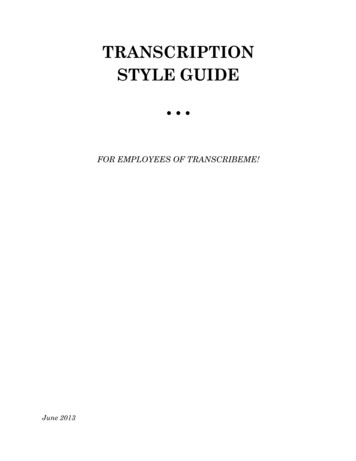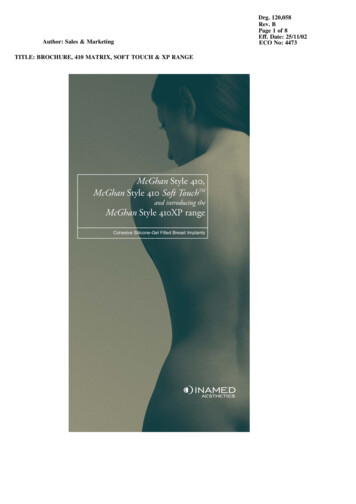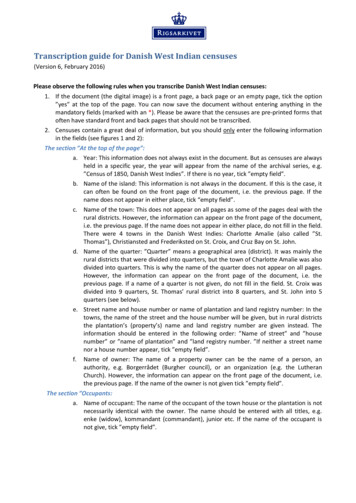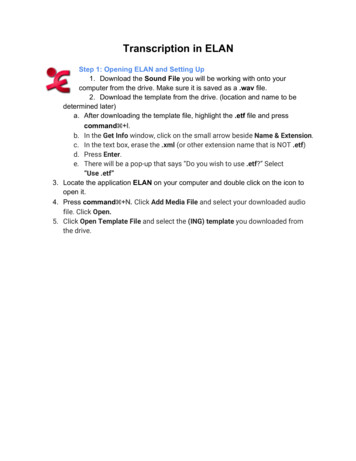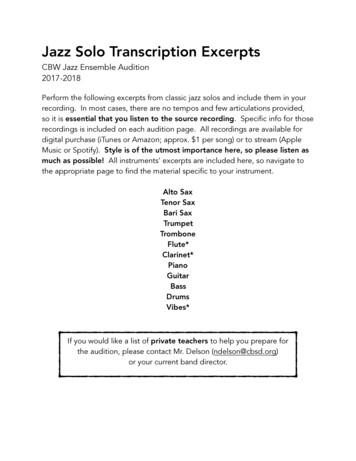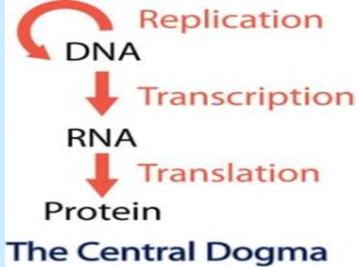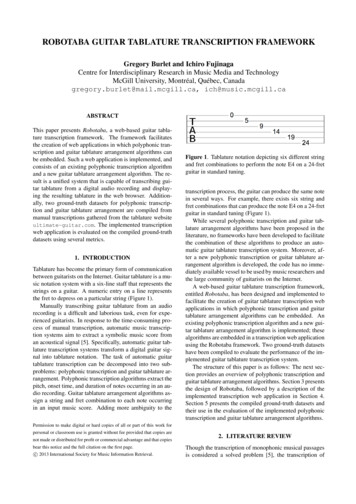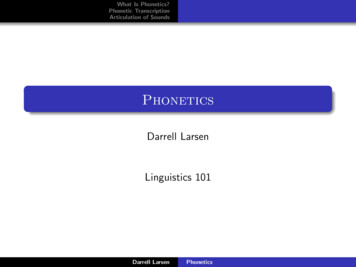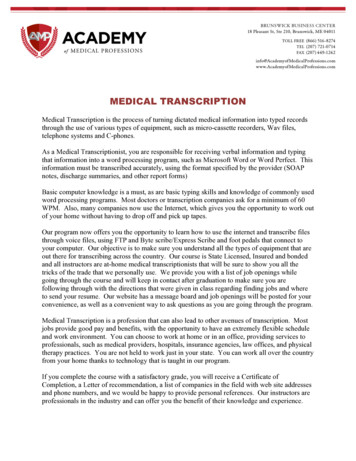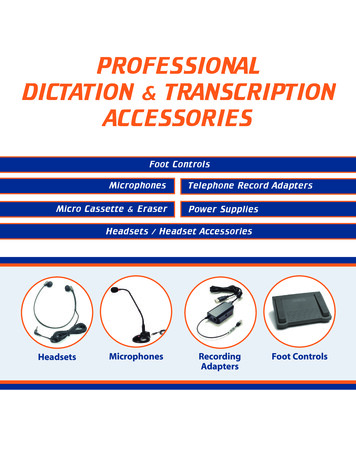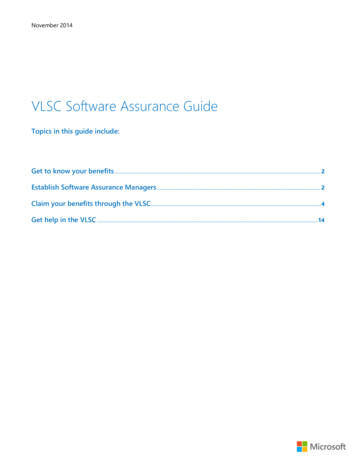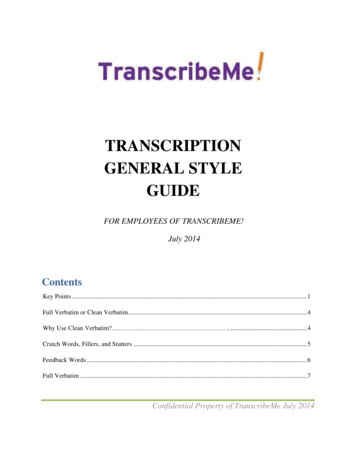
Transcription
TRANSCRIPTIONGENERAL STYLEGUIDEFOR EMPLOYEES OF TRANSCRIBEME!July 2014ContentsKey Points . 1Full Verbatim or Clean Verbatim . 4Why Use Clean Verbatim?. . 4Crutch Words, Fillers, and Stutters . 5Feedback Words . 6Full Verbatim . 7Confidential Property of TranscribeMe July 2014
How to Build Sentences . 7Clauses and Sentences . 8Conjunctions . 9Punctuation . 9Commas . 10Hyphens . 12Apostrophes . 13Colons and Semicolons . 15Quotation Marks . 16Dashes . 19The Ellipsis . 20Transcription Style . 20False Starts and Interruptions . 20Tagging Non-verbal Sounds and Inaudible Speech . 22Numbers . 25Common Spelling and Grammar errors. 26General guidelines . 27Useful resources . 28Confidential Property of TranscribeMe July 2014
1Key Points to remember as you work on filesPlease find a quick guide below of some key points to remember, which is then followed by thefull style guide.Misheard words: Please listen to the audio closely to ensure you are hearing words correctlyand that your sentences actually make sense. If the sentence does not read correctly or doesnot make sense then please listen again for any misheard words. A good tool to use is DFXAudio Enhancer. This can help with the volume on some files, also if you're serious aboutdoing transcription work it's always best to invest in a good pair of noise cancellingheadphones. Too many [?] or [inaudible] could cause one of your files to be rejected.Starting and ending files with ellipses, dashes or any other punctuation: You will be transcribingsmall micro tasks and these micro tasks are then put back together for a QA, which means youare NEVER to start or end a file with any sort of punctuation. You would only capitalize thefirst word of the file if a proper noun.Inserting speaker ID: Never do any sort of speaker ID on a file you are transcribing. The QA'sor transcribers that do single-step sessions input speaker ID. Doing so will get your filesrejected.Approved tags: We do not make up our own tags. Valid tags are, [silence], [laughter],[chuckles], [music], [inaudible], [applause], [foreign], [crosstalk], [?]. Never capitalize a tag. Alltags go within the sentence and within the punctuation of that sentence. The [silence] taggoes on a line alone. The [music] and [applause] tags go outside of the punctuation. Using anyother tags can cause your file to be rejected.Filler words: In a clean verbatim file we do not use filler words. Some examples of filler wordscan be; Yeah, Oh, You know, Like, Okay, Uh, Um.Clean verbatim versus full verbatim: Please make sure you are checking the file to find outwhat the requirements are for that particular file. We have several different styles that ourclients require and you will find this information on the right hand side of the transcriptionbox. Doing Um and Ah's on a clean verbatim file can cause rejections of your hard work.Numbers: All numbers below nine are to be written out. Percentages are to be done as %.Confidential Property of TranscribeMe July 2014
2Money should be written as 40 or 40 million. It is fine to start a sentence with a number if itis above ten. The main thing is to keep the number consistent throughout the sentence.Fractions are to be written out e.g three-fifths, time should be written as 8:30 AM.False starts: A false start is where a speaker starts a sentence but corrects the thought veryquickly and moves on. Generally, false starts involve just a few words and can safely beomitted. Example: The speaker says - I stayed I went to the park. You would type - I went tothe park. I stayed would be a false start and can safely be left out. You can also omit Yeah,Okay replies from other speakers when it is not a response to a direct question.In a clean verbatim files you are always to transcribe the words the speakers say, even if thespeaker has poor grammar and cannot put together a sentence correctly. The only exceptionsto this would be the words, wanna, gonna, kinda should always be written properly in a cleanverbatim file as - want to, going to, kind of, only in a full verbatim file would use write them asthey are spoken. So please DO NOT write wanna, gonna, kinda in a clean verbatim file.In clean verbatim files you are not to expand out contractions, if the speaker says it's you DONOT expand this out. If the speaker says they're you DO NOT expand it out. The word OkayIS NOT written, as OK. The word because SHOULD NOT be written as 'cause and shouldalways be written out. All right for alright, A lot for alot.The use of ellipses and dashes can be very confusing at times, but if you follow this simple ruleyou will have no problems. Double dashes are used for when a speaker changes thought inmid-sentence or has been interrupted by another speaker.Tom and Iweregoing tothe-- DidJerry gowith you?--game on Monday.Confidential Property of TranscribeMe July 2014
3Please notice how the double dashes are used to continue the interrupted sentence from thefirst speaker. You would not capitalize the continued sentence unless it was a proper noun.Jerry decided that he was-- he went to the pool instead.Please notice how after the double dashes you would not space before but use one space afterand never capitalize the next word after the double dash unless it is a proper noun.Ellipses are used when a speaker trails off.Did you see when ? [The speaker stops speaking and pauses giving the other person achance to reply]. Do not over use ellipses during transcription. We try to use them sparinglyand most times the double dash is needed because it is a change of thought.Quotes are only used for actual quotes and nothing else. Punctuation goes within the quotes.Please make sure you read full rules on this in the style-guide. Names of books need to becapitalized.Confidential Property of TranscribeMe July 2014
4IntroductionThis style guide is for transcribers and QAs to use in their work atTranscribeMe and discusses general guidelines, punctuation, sentence structure,grammar, proper tag usage, and types of transcription. This style guide is notintended to be an exhaustive or complete guide to English grammar and syntax, asthe rules outlined here have been implemented to meet the particular demands oftranscription.Some clients may have specific requirements that are not in the style guide, andmay even contradict the style guide. It is always important to check the guidelineson the work hub for client-specific requirements before you begin anytranscription job or QA session. Please note: American spelling and punctuationrules are used in this style guide. If you will be working in the Commonwealthteam, please refer to that guide for differences in spelling and punctuation.If you have any concerns about the style guide, or feel that something has been leftout of the guide, please e-mail shiftlead@transcribeme.com.Full Verbatim or Clean Verbatim?The default method for transcribing and reviewing documents in TranscribeMe isclean verbatim. Transcribing clean verbatim will often require the transcriber orQA to use their best judgment to decide whether certain words or phrases shouldbe omitted. Transcribing clean verbatim should not be a daunting task, however.This section will provide a clear explanation of why clean verbatim is used, andwill include examples of the difference between full verbatim and clean verbatim.Why Use Clean Verbatim?Clean verbatim is an approach to transcribing which ensures that the transcriptionis clear, succinct, and easy to read, while at the same time preserves essentialConfidential Property of TranscribeMe July 2014
5information and meaning. Clean verbatim means that erroneous speech – such ascrutch words and fillers – is omitted from the final document.Clean verbatim also means that non-formal truncations of single words arecorrected to the proper spelling. Words like gonna, 'cause, wanna, and dunnoshould be corrected to going to, because, want to, and don't know.Words like ain't and ya'll are are regional slang and can be left in clean verbatimjobs.You will not expand contractions like don't, can't, or won't. Also, do not changewords like it is or do not to it's or don't. However they are spoken, please leave theoriginal words.Crutch Words, Fillers and StuttersThe most common features of speech altered by clean verbatim are stutters, fillerwords and crutch words. Crutch words and filler words are erroneous additionsto a sentence that do not add meaning or coherency to a sentence. They areusually used when a speaker is searching for a thought or deciding how toproperly express what he or she is trying to say. They may also be used to elicitfeedback from another speaker or audience.Examples of crutch words and fillers can include the common um and uh, as wellas phrases like you know, like, I mean, I guess and maybe. It is important thatwords like these are properly identified as crutches or fillers, because these termscan obviously be used in a way that is important to the meaning of a sentence. Youcan usually tell crutch words and fillers based on the context of their use and theway they are spoken. Consider the following examples:Audio Example:And, I guess just maybe thinking of your other ideas and some of the,like, um, suggestions you made earlierCorrect removal of crutch and filler words:Confidential Property of TranscribeMe July 2014
6And, I guess just thinking of your other ideas and some of the suggestions youmade earlierYou could also do this:And just thinking of your other ideas and some of the suggestions you madeearlierImportant: The word like can be deceptive. At times it may sound like it is beingused as a crutch word when it is really being used to signify an approximation. Forinstance, "I was in bed for like two weeks" is a sentence where like is being used asan approximation of time and should not be omitted.Stutters should be easier to identify. A stutter is the unnecessary repetition of aword or sound and should always be omitted in clean verbatim. However, pleaseinclude words that are repeated deliberately for emphasis."The, the, the p-p-pizza was really, really good," should be transcribed as, "Thepizza was really, really good."Feedback WordsWhile working for TranscribeMe, you will frequently be required to transcribeinterviews, meetings, and other audio files involving two or more speakers. Inthese audio files, you will usually hear people respond to the speaker usingfeedback words, such as yeah, right, okay, etc.Please omit these feedback words and any feedback words like them if they arestand-alone interjections, or are not responses to a specific question that requiresa response. Consider the following examples. Please note that you do not have toindicate different speakers as “S1”, “S2” etc. in your actual transcriptions unlessyou are a QA. They are indicated this way for purposes of the example only.Incorrect:Confidential Property of TranscribeMe July 2014
7S1: I thought
This style guide is for transcribers and QAs to use in their work at TranscribeMe and discusses general guidelines, punctuation, sentence structure, grammar, proper tag usage, and types of transcription. This style guide is not intended to be an exhaustive or complete guide to English grammar and syntax, as the rules outlined here have been implemented to meet the particular demands of .
